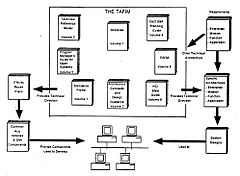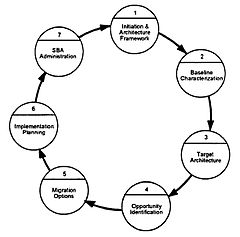Enterprise architecture (EA) is a business function concerned with the structures and behaviors of a business, especially business roles and processes that create and use business data. By international consensus, Enterprise Architecture has been defined as "a well-defined practice for conducting enterprise analysis, design, planning, and implementation, using a comprehensive approach at all times, for the successful development and execution of strategy. Enterprise architecture applies architecture principles and practices to guide organizations through the business, information, process, and technology changes necessary to execute their strategies. These practices utilize the various aspects of an enterprise to identify, motivate, and achieve these changes."

The Open Group Architecture Framework (TOGAF) is the most used framework for enterprise architecture as of 2020 that provides an approach for designing, planning, implementing, and governing an enterprise information technology architecture. TOGAF is a high-level approach to design. It is typically modeled at four levels: Business, Application, Data, and Technology. It relies heavily on modularization, standardization, and already existing, proven technologies and products.

The Department of Defense Architecture Framework (DoDAF) is an architecture framework for the United States Department of Defense (DoD) that provides visualization infrastructure for specific stakeholders concerns through viewpoints organized by various views. These views are artifacts for visualizing, understanding, and assimilating the broad scope and complexities of an architecture description through tabular, structural, behavioral, ontological, pictorial, temporal, graphical, probabilistic, or alternative conceptual means. The current release is DoDAF 2.02.
A federal enterprise architecture framework (FEAF) is the U.S. reference enterprise architecture of a federal government. It provides a common approach for the integration of strategic, business and technology management as part of organization design and performance improvement.

Unicom System Architect is an enterprise architecture tool that is used by the business and technology departments of corporations and government agencies to model their business operations and the systems, applications, and databases that support them. System Architect is used to build architectures using various frameworks including TOGAF, ArchiMate, DoDAF, MODAF, NAF and standard method notations such as sysML, UML, BPMN, and relational data modeling. System Architect is developed by UNICOM Systems, a division of UNICOM Global, a United States-based company.
Data architecture consist of models, policies, rules, and standards that govern which data is collected and how it is stored, arranged, integrated, and put to use in data systems and in organizations. Data is usually one of several architecture domains that form the pillars of an enterprise architecture or solution architecture.

An enterprise architecture framework defines how to create and use an enterprise architecture. An architecture framework provides principles and practices for creating and using the architecture description of a system. It structures architects' thinking by dividing the architecture description into domains, layers, or views, and offers models - typically matrices and diagrams - for documenting each view. This allows for making systemic design decisions on all the components of the system and making long-term decisions around new design requirements, sustainability, and support.
A reference model—in systems, enterprise, and software engineering—is an abstract framework or domain-specific ontology consisting of an interlinked set of clearly defined concepts produced by an expert or body of experts to encourage clear communication. A reference model can represent the component parts of any consistent idea, from business functions to system components, as long as it represents a complete set. This frame of reference can then be used to communicate ideas clearly among members of the same community.
Enterprise information security architecture (ZBI) is a part of enterprise architecture focusing on information security throughout the enterprise. The name implies a difference that may not exist between small/medium-sized businesses and larger organizations.

Enterprise modelling is the abstract representation, description and definition of the structure, processes, information and resources of an identifiable business, government body, or other large organization.
In information systems, applications architecture or application architecture is one of several architecture domains that form the pillars of an enterprise architecture (EA).

A view model or viewpoints framework in systems engineering, software engineering, and enterprise engineering is a framework which defines a coherent set of views to be used in the construction of a system architecture, software architecture, or enterprise architecture. A view is a representation of a whole system from the perspective of a related set of concerns.

Treasury Enterprise Architecture Framework (TEAF) was an enterprise architecture framework for treasury, based on the Zachman Framework. It was developed by the US Department of the Treasury and published in July 2000. May 2012 this framework has been subsumed by evolving Federal Enterprise Architecture Policy as documented in "The Common Approach to Federal Enterprise Architecture".

Core architecture data model (CADM) in enterprise architecture is a logical data model of information used to describe and build architectures.

Open-system environment (OSE) reference model (RM) or OSE reference model (OSE/RM) is a 1990 reference model for enterprise architecture. It provides a framework for describing open system concepts and defining a lexicon of terms, that can be agreed upon generally by all interested parties.

NIST Enterprise Architecture Model is a late-1980s reference model for enterprise architecture. It defines an enterprise architecture by the interrelationship between an enterprise's business, information, and technology environments.

The Treasury Information System Architecture Framework (TISAF) is an early 1990s Enterprise Architecture framework to assist US Treasury Bureaus to develop their Enterprise Information System Architectures (EISAs).
Enterprise interoperability is the ability of an enterprise—a company or other large organization—to functionally link activities, such as product design, supply chains, manufacturing, in an efficient and competitive way.
Jaap Schekkerman is a Dutch computer scientist and founder of the Institute For Enterprise Architecture Developments (IFEAD) in the Netherlands. He is particularly known for his 2003 book How to Survive in the Jungle of Enterprise Architecture in which he compared 14 Enterprise Architecture Frameworks.

The Application Portability Profile (APP) is a 1990s framework for Open-System Environment designed by the NIST for use by the U.S. Government. It contains a selected suite of specifications that defines the interfaces, services, protocols, and data formats for a particular class or domain of applications.


















